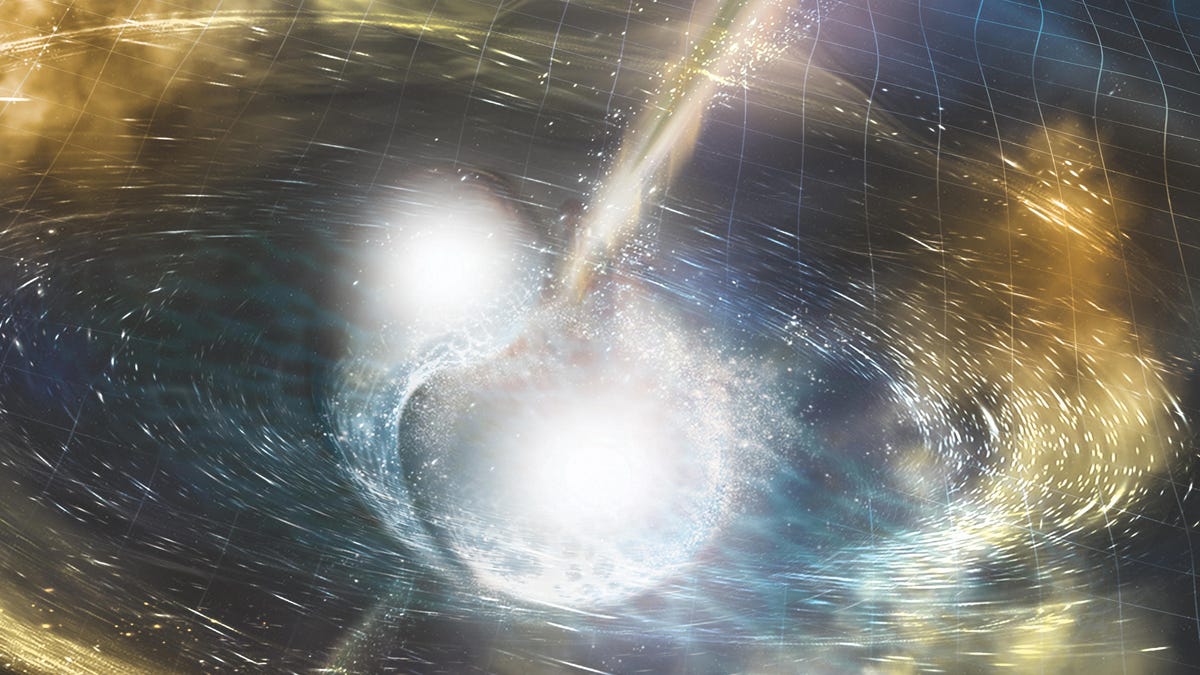Explosive neutron star collision is still emitting X-rays, puzzling astronomers
The first-ever neutron star merger detected by gravitational waves is still giving off X-rays and scientists aren't sure why.

Two neutron stars colliding, generating gravitational waves and a huge, bright jet.
When two neutron stars smashed into each other, about 130 million light-years from Earth, the universe lit up. The collision, between some of the densest objects in the cosmos, produced gravitational waves and a spattering of fireworks on Aug. 17, 2017. Dozens of telescopes on Earth captured the rare merger across different wavelengths of the electromagnetic spectrum. First, there came a burst of highly energetic gamma rays, followed by bursts of light and UV, radio and infrared signals.
About nine days after the collision, NASA's Chandra observatory picked up an X-ray signal. According to our understanding of neutron stars, it should have faded away by now.
But in a new study, published Monday in the journal Monthly Notices of the Royal Astronomical Society, researchers have studied the neutron-star-on-neutron-star impact, designated GW170817, and discovered that 1,000 days later, the X-ray signal was still detectable.
"We really don't know what to expect from this point forward, because all our models were predicting no X-rays," said Eleonora Troja, an astrophysicist at NASA's Goddard Space Flight Center and lead author on the study, in a press release.
GW170817 is the first neutron star merger detected by the three gravitational wave observatories stationed on Earth. The triad of observatories were able to triangulate the position of the merger moments after it happened, allowing researchers to turn their telescopes to space and get a good look at the event. And it's a violent one.
See also: These telescopes work with your phone to show exactly what's in the sky
Because we haven't seen many neutron star collisions (only two have been recorded and confirmed so far), scientists have had to rely on models to predict the aftermath. For the most part, the models lined up with what was detected with GW170817. When two neutron stars collide, they release a jet of gamma rays and a huge blast of bright gas, known as a "kilonova." Those events are transient -- we see them for a few days or weeks and then they disappear. That was the case with GW170817.
But Chandra, NASA's X-ray observatory, was still detecting X-rays at the location when it focused on the merger in February, two and a half years after it flared to life. The latest measurements show the signal has faded, but the specter of an X-ray burst is still visible and it's a little brighter than models predicted. Why are these X-rays still visible? That's a puzzle the researchers are trying to solve.
It may be there's an additional component of the neutron star mergers models have not previously accounted for. Or perhaps the dynamics of the energy released in the aftermath of the collision are a little different to what we expect. An exciting possibility is that the remains of the merger represent an X-ray-emitting neutron star -- though much more analysis is required to determine where the signal is coming from. Astronomers will turn their telescopes to GW170817 in December, presenting another opportunity to unravel the mystery in the merger.
"Whatever happens, this event is changing what we know about neutron star mergers and rewriting our models," said Troja.

